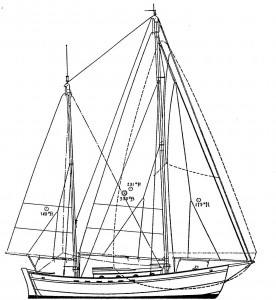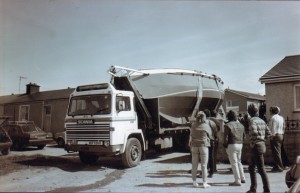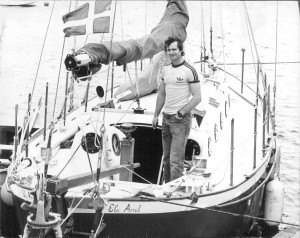
A short history
In 1977 I was 18, mad keen on sailing and wanted to travel and see the world. I thought it would be a great idea to combine these two things and build a boat to sail to all the places I wanted. I didn’t have the skill to build a boat in wood or fibreglass but I was serving an apprenticeship as a blacksmith and I could weld two bits of steel together. Six years later I had resolved that I would stop just thinking about building a steel boat to sail round the world in and actually do it.
I had plans for a 33’ steel yacht of French design and had also looked at building an Endurance 37.
I began to look at different designs and see what had worked in the past and what was really suitable for the trip I wanted to do.
Above all I wanted a safe boat; a sea worthy boat; a boat that would get me there and get me back again.
The more I looked into designs that were considered sea worthy the more I found that certain yachts were described as being “as sea worthy as the old Tahiti ketches”. What were Tahiti ketches? I’d never heard of them before. But if they were using these yachts as a benchmark to measure the sea keeping qualities of other yachts then I should find out more about them.
keeping qualities of other yachts then I should find out more about them.
I browsed the maritime section of the local library and found an article that confirmed the good sea keeping qualities of Tahiti ketches. There were photos to accompany the article and so I saw a Tahiti ketch for the first time.
The hull shape looked very similar to a big Shetland model. She was heeled over in a fresh breeze with a rush of white water at her bow. There is an old and true saying that a boat, which is a good sea boat, will look good; will look just right, from any angle. I was drawn to it instantly. I’m sure something clicked inside me at the time to tell me this was the boat to build.
An American naval architect, John Hanna, originally designed the Tahiti ketch. She started life on his drawing board in Florida in 1923 as a wooden boat named Neptune and she was designed for a dentist in Texas. She initially generated just a passing interest and only about a dozen sets of plans were sold during the next twelve years. That all changed when she appeared in the American magazine Modern Mechanix (which became Mechanix Illustrated) in 1935. The magazine was aimed at the average home handyman. It was very popular and sold nationwide. It was certainly available in the UK too. Dad was keen on DIY How-to-do-it magazines and I remember a whole pile of issues up on our loft. For a time during the 1930’s they had an annual supplement – How to Build 20 Boats- featuring projects that anyone with a bit of DIY know-how could build in his own backyard.
The magazine’s editor was a fellow naval architect and life-long friend of Hanna’s, Weston Farmer. He had known about the boat for some time and he asked Hanna if he would care to submit the plans for the next supplement. Before it went to print Farmer changed the original name and the readers first saw drawings of this boat under the headline, – Sail “Tahiti,” A 30’ Deep Sea auxiliary Cruiser. The journalist in Farmer thought the name would throw a ray of sunshine into the lives of his Depression blighted readers.
Weston Farmer acquired the rights to John Hanna’s plans and in 1976 he redesigned his old Tahiti ketch to be built in steel with a chined hull rather than a round one. He named his new model, Tahitiana, Polynesian for, Daughter of Tahiti. In his article advertising her he said, “Tahitiana is still a poor man’s boat. She can be put up, as to hull, for about the price of a good automobile”. It is estimated that about 700 were built (in wood and in steel), most of them in the States. At least 15 of them have circumnavigated. Two of the most well known are Adios in which Tom Steele did two circumnavigations, and Jean Gau’s Atom which completed three circumnavigations and at least ten Atlantic crossings.
I had to find a shed big enough to build my boat in. There were a few places around but they were either too costly to rent or too far away to be practical for working on each day. The Hamnavoe shop had a shed, an old semi-circular steel Nissen hut, the kind that looks like a huge baked bean tin sliced in half lengthways. They were developed during WW1 by a Canadian engineer, Major Peter Nissen, as an easy to assemble storehouse that six men could put up between meal times.

The men who built the new Hamnavoe pier in 1956 put up this one and they used it as a work hut. It was available at the right price and it was less than two minutes walk from the house. The only problem was that it wasn’t big enough to build my boat in.
I applied for planning permission to heighten it. My plan was to take it apart, build a metre high brick wall all round then set the shed back on top of it. But the application was turned down. I needed somewhere to build and because the shed was so handy it made sense to use it and if I couldn’t go up I would have to make room by digging down instead.
I dug out a pit running the length of the shed and concreted the walls smooth. It was deep enough and wide enough to set the keel down into. The shed wasn’t long enough either so I nailed together a temporary plywood extension on to the end of it.
A footnote that came with the plans added that the measurements were “believed accurate but not guaranteed”. To be sure the drawings were correct I had to loft, or re-draw, the boat out half size on the shed floor. On the bigger scale it was easier to spot mistakes in the plans. At the start of December in 1984 I re-drew the lines on to two sheets of hardboard and made a new set of measurements from there.
Today you can order steel boat “kits” where all the steel sections arrive pre-cut by a laser, which is following a computer drawing. When the steel arrives it is a bit like flat pack furniture ready to be assembled but using a welder instead of a screwdriver. Elsi wasn’t like that. The steel for the hull was straight out of the rack in big sheets. Flat-bar and angle iron were in long lengths which had to be cut to size and shaped. It all arrived in early March 1985.
A week later the first piece of steel was cut and Elsi began to be born!
To bend the box section for the deck and coachroof beams I made up a press using a section of H-beam and a hydraulic jack from the old shop truck. My brother-in-law, Michael, beefed up the wiring in the shed to cope with the heavy demands of the welder.
Building a steel boat is a bit like building a steel shed. You make up a framework and then cover it over so that it is wind and watertight. The obvious difference with a boat is that it is helpful if it is completely watertight…
I made up all the frames first and as the days grew longer and it turned to summer the keel was laid and the frames set up on it. It looked a bit like the skeleton of a brontosaurus laying on its back.
There was always someone who would pop in to see what was happening. If I had stopped to yarn with them all I would still be building yet. The only way was to work and talk and keep at it.
The pit in the shed enabled me to build Elsi there but it had one huge drawback. It filled up with water every time it rained. To begin with it wasn’t so bad and I used to go down with a bucket and scoop it out. But as summer grew into winter and the weather got worse some mornings I would get there to find a metre or more of rainwater to get rid of. For my next birthday Mum bought me an electric bilge pump. It could pump away while I was working and made a huge difference.
I was constrained by the height of the shed as well. There was very little headroom above the deck to work on it. It wasn’t possible to stand up and the gunwhales were fairly near to the shed on each side.
Luckily, Elsi was a reasonably easy boat to build. There were no complex curves to shape. All the steel plates tended to wrap easily around the frames, just as Weston Farmer had intended.
Over the next year the plates were all cut and welded in place. The deck was all plated up, the cockpit was finished just before Christmas and all the main hull welding was completed in the summer of the following year.
By March of 1987 she was being painted then fitted out with a temporary inside and she was launched two months later on 16th May. Rather than use the original ketch sail plan I rigged her as a cutter, (a single mast with two head sails).









Recent Comments